
The Yemeni Armed Forces are the military forces of the Republic of Yemen. They include the Yemeni Army, Yemeni Navy and the Yemeni Air Force. Since the start of the current civil war in 2014, the armed forces have been divided; at first between loyalists of the former president Ali Abdullah Saleh and pro-Yemeni government forces of president Abdrabbuh Mansour Hadi; as of 2024, between the internationally recognized Presidential Leadership Council (PLC), and the Houthi-led Supreme Political Council (SPC). Per the constitution, the President of Yemen serves as the commander-in-chief. Currently, the presidency and supreme command of the armed forces is disputed between Rashad al-Alimi, Chairman of the PLC, and Mahdi al-Mashat, chairman of the SPC. Before the civil war, the united military was headquartered in the country's capital, Sana’a.
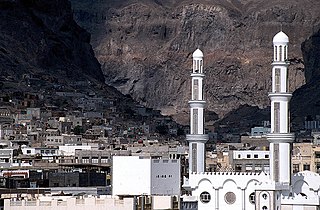
Aden is a port city located in Yemen in the southern part of the Arabian peninsula, positioned near the eastern approach to the Red Sea. It is situated approximately 170 km east of the Bab-el-Mandeb strait and north of the Gulf of Aden. With its strategic location on the coastline, Aden serves as a gateway between the Red Sea and the Arabian Sea, making it a crucial maritime hub connecting Africa, Asia, and the Middle East. As of 2023, Aden City has a population of approximately 1,080,000 residents, making it one of the largest cities in Yemen. Aden is divided into eight districts: Tawahi, Mualla, Crater, Khur Maksar, Al Mansura, Dar Sad, Sheikh Othman, and Al Buraiqa. These form today's Aden Governorate. During British Colonialism, Aden referred to the area along the north coast of the Gulf of Aden, encompassing Tawahi, Mualla, Crater, and much of Khur Maksar District. The western harbor peninsula, known as Little Aden, now falls within the Al Buraiqa District.

The New Zealand and Australian Division was a composite army division raised for service in the First World War under the command of Major General Alexander Godley. Consisting of several mounted and standard infantry brigades from both New Zealand and Australia, it served in the Gallipoli Campaign between April and December 1915.
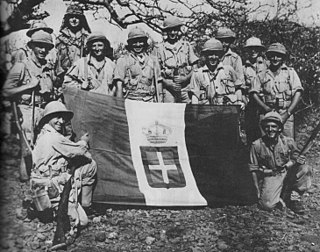
The East African campaign was fought in East Africa during the Second World War by Allies of World War II, mainly from the British Empire, against Italy and its colony of Italian East Africa, between June 1940 and November 1941. The British Middle East Command with troops from the United Kingdom, South Africa, British India, Uganda Protectorate, Kenya, Somaliland, West Africa, Northern and Southern Rhodesia, Sudan and Nyasaland participated in the campaign. These were joined by the Allied Force Publique of Belgian Congo, Imperial Ethiopian Arbegnoch and a small unit of Free French Forces.
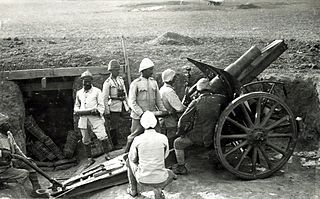
The Sinai and Palestine campaign was part of the Middle Eastern theatre of World War I, taking place between January 1915 and October 1918. The British Empire, the French Third Republic, and the Kingdom of Italy fought alongside the Arab Revolt in opposition to the Ottoman Empire, the German Empire, and the Austro-Hungarian Empire. It started with an Ottoman attempt at raiding the Suez Canal in 1915 and ended with the Armistice of Mudros in 1918, leading to the cession of Ottoman Syria.

The Aden Protectorate was a British protectorate in southern Arabia. The protectorate evolved in the hinterland of the port of Aden and in the Hadhramaut after the conquest of Aden by the Bombay Presidency of British India in January 1839, and which continued until the 1960s. In 1940, it was divided for administrative purposes into the Western Protectorate and the Eastern Protectorate. The territory now forms part of the Republic of Yemen.

Lahej, the Sultanate of Lahej, or, sometimes, the Abdali Sultanate, was a Sheikdom based in Lahij in Southern Arabia. The Sultanate became self-ruling in 1728 and gained independence in 1740. In 1839, the Sultanate became part of the Aden Protectorate of the British Empire, though nominally the 'Abdali Sultan retained his status. The Aden Protectorate was briefly ruled again by the Ottomans during World War I, but regained by the British after the Ottoman defeat in World War I and absorbed into Federation of South Arabia in 1963. The 'Abdali dynasty was officially abolished in 1967, with the proclamation of South Yemen.

The Raid on the Suez Canal, also known as Actions on the Suez Canal, took place between 26 January and 4 February 1915 when a German-led Ottoman Army force advanced from Southern Palestine to attack the British Empire-protected Suez Canal, marking the beginning of the Sinai and Palestine Campaign (1915–1918) of World War I (1914–1918).

The Aden Emergency, also known as the 14 October Revolution or as the Radfan Uprising, was an armed rebellion by the National Liberation Front (NLF) and the Front for the Liberation of Occupied South Yemen (FLOSY) against the Federation of South Arabia, a British Protectorate of the United Kingdom, which led to the proclamation of the People's Republic of South Yemen.
The 10th Indian Division was an infantry division of the British Indian Army during World War I. It was formed in Egypt in December 1914 with three infantry brigades of Indian Expeditionary Force F. After taking part in the Actions on the Suez Canal, the division was dispersed as its brigades were posted away.

The Indian Army, also called the British Indian Army, was involved in World War I as part of the British Empire. More than one million Indian troops served overseas, of whom more than 60,000 died during the war.

The Aden Protectorate Levies (APL) was a military force recruited from indigenous tribal populations, for the local defence of the Aden Protectorate under British rule. The Levies were drawn from all parts of the Protectorate and were armed, trained and officered by the Indian Army, Royal Air Force and British Army at various stages in the history of the force. They used the Lahej emblem of crossed jambiyah as their badge.

The Battle of Sheikh Sa'ad occurred between 6–8 January 1916 during the Mesopotamian Campaign of the First World War. The battle took place along the banks of the Tigris River between the Anglo-Indian Tigris Corps and elements of the Ottoman Sixth Army. The engagement was the first in a series of assaults by the Tigris Corps to try to break through the Ottoman lines to relieve the besieged garrison at Kut.

The Battle of Katia, also known as the Affair of Qatia by the British, was an engagement fought east of the Suez Canal and north of El Ferdan Station, in the vicinity of Katia and Oghratina, on 23 April 1916 during the Defence of the Suez Canal Campaign of World War I. An Ottoman force led by the German General Friedrich Freiherr Kress von Kressenstein made a surprise attack on three and a half squadrons of the British 5th Mounted Brigade, which was widely scattered to the east of Romani. The mounted brigade had been ordered to the area to protect the new railway and water pipeline being built from Kantara on the Suez Canal, as this infrastructure extended out past the Canal's zone of defences into the Sinai Peninsula towards Romani. Kress Von Kressenstein's attack was completely successful, decimating the equivalent of little more than a regiment. On the same day, an associated Ottoman attack on Duidar, very close to the Suez Canal, failed when it met with strong British opposition.

The campaign in South Arabia during World War I was a minor struggle for control of the port city of Aden, an important way station for ships on their way from Asia to the Suez Canal. The British Empire declared war on the Ottoman Empire on 5 November 1914, and the Ottomans responded with their own declaration on 11 November. From the beginning, the Ottomans had planned an invasion of Britain's Aden Protectorate in cooperation with the local Arab tribes. The Ottomans had gathered in some strength on the Cheikh Saïd, a peninsula which juts out into the Red Sea towards the island of Perim.
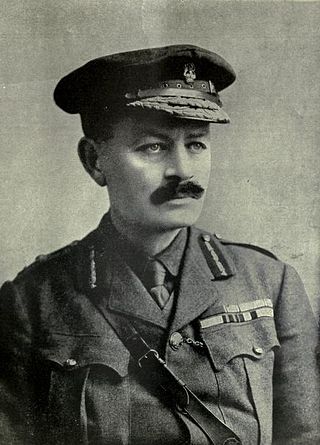
The Force in Egypt was a British Army formation established in August 1914 to administer garrisoning armed forces in Egypt at the beginning of the First World War. The force had the objective of protecting the Suez Canal and was originally commanded by Major General Julian Byng, but he was replaced by General J. Maxwell, who took command on 8 September 1914. Initially, the main threat to the Suez came from Germany and throughout the early months several of the force's elements were sent to Europe to take part in the fighting on the Western Front. On 5 November 1914, Britain and France declared war on the Ottoman Empire, after which the Force in Egypt faced a direct threat from Ottoman forces, which was realised in February 1915 with a raid on the Suez Canal. This threat remained until 1916 when the British forces went on the offensive.

Major-General Sir Philip Charles Palin was an officer of the British Indian Army who served in frontier campaigns and then commanded British, Indian and South African troops in Egypt, Gallipoli and Palestine during World War I. Postwar he chaired an inquiry into the Arab–Jewish conflict in Jerusalem.
The 28th Indian Brigade was an infantry brigade of the British Indian Army that saw active service with the Indian Army during the First World War. Formed in October 1914, it defended the Suez Canal in early 1915, ended the Ottoman threat to Aden in July 1915, took part in the Mesopotamian Campaign in 1916 and 1917, before finishing the war in the Sinai and Palestine Campaign. It remained in Palestine until it was broken up in 1920.
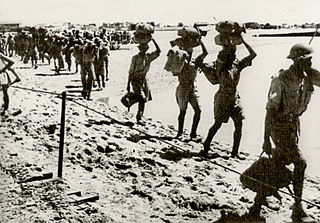
Operation Appearance was a British landing in the British Somaliland Protectorate against troops of the Italian Army. The Italian conquest of British Somaliland had taken place seven months previously, in August 1940. The British had withdrawn from the protectorate after a delaying action at the Battle of Tug Argan. This withdrawal, after the disastrous conclusion of the Battle of France and the Italian declaration of war on 10 June 1940, had repercussions among British leaders. It led Prime Minister Winston Churchill to lose confidence in General Archibald Wavell, the British commander in the Middle East, which culminated in Wavell's sacking on 20 June 1941.

The Baidah Sultanate was a state in South Arabia.



















